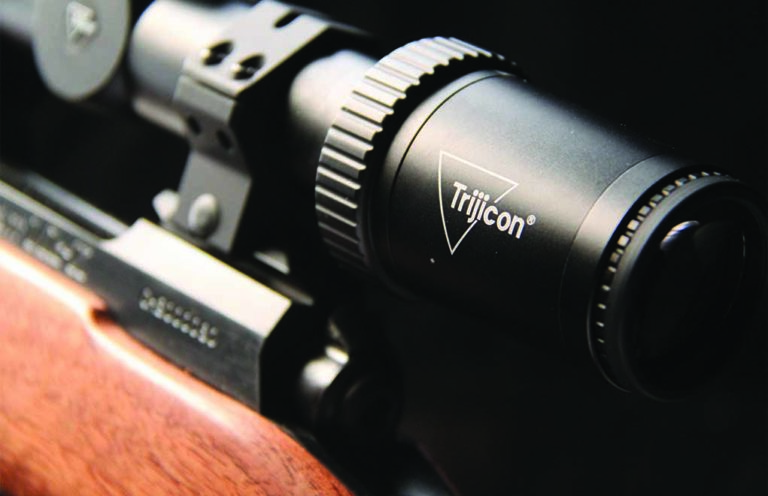
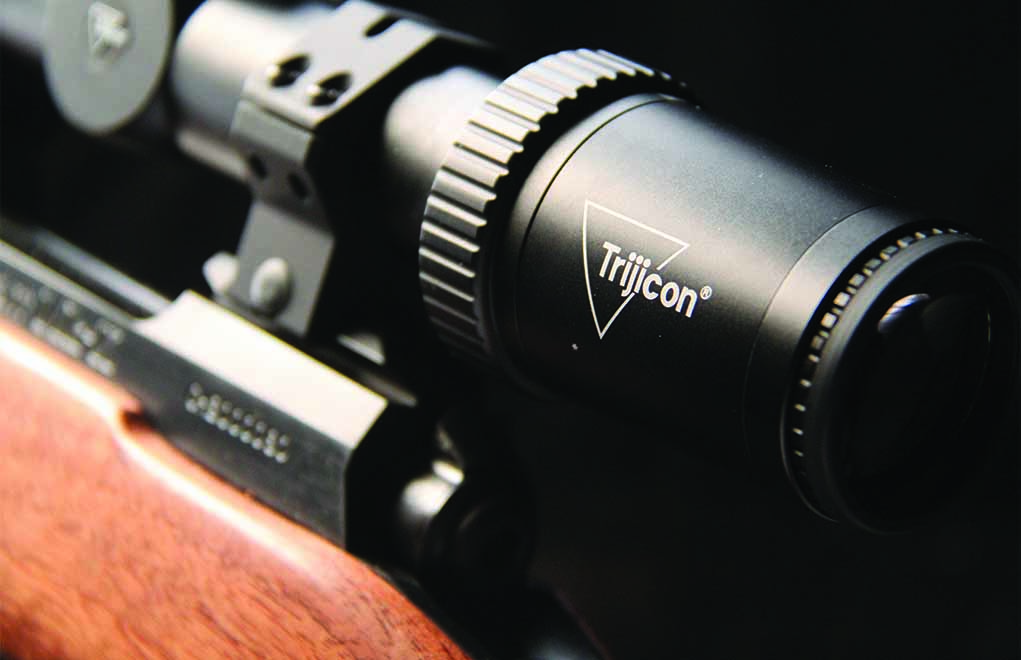
In sub-zero conditions, the Trijicon Huron riflescope still put whitetails on ice.
The big news from Trijicon for 2020 is certainly the release of its groundbreaking Ventus, a portable rangefinder that doubles as a sophisticated wind mapping device. As significant an advancement as the Ventus is, it’s hardly Trijicon’s only new product for 2020: The company is offering a whole host of brand-new scopes for hunters and shooters.
Huron Scopes
One of the new Trijicon releases is the Huron line, a family of optics that’s aimed at (pun intended!) the white-tailed deer hunter. The whitetail is, far and away, the most popular big-game animal in North America, and approximately 80 percent of the hunters who head to the field each year do so in search of whitetails. As a result, it makes sense that Trijicon would make an effort to build the perfect deer scope … if such a thing exists.
If it does, it might be the Huron.
Trijicon optics have a reputation for superb clarity and excellent construction, but optics of that caliber don’t come cheap. In designing the Huron, Trijicon’s engineers set out to provide the same level of optical quality at a price that would be more palatable to the average deer hunter by providing them with every feature they need and nothing they don’t.
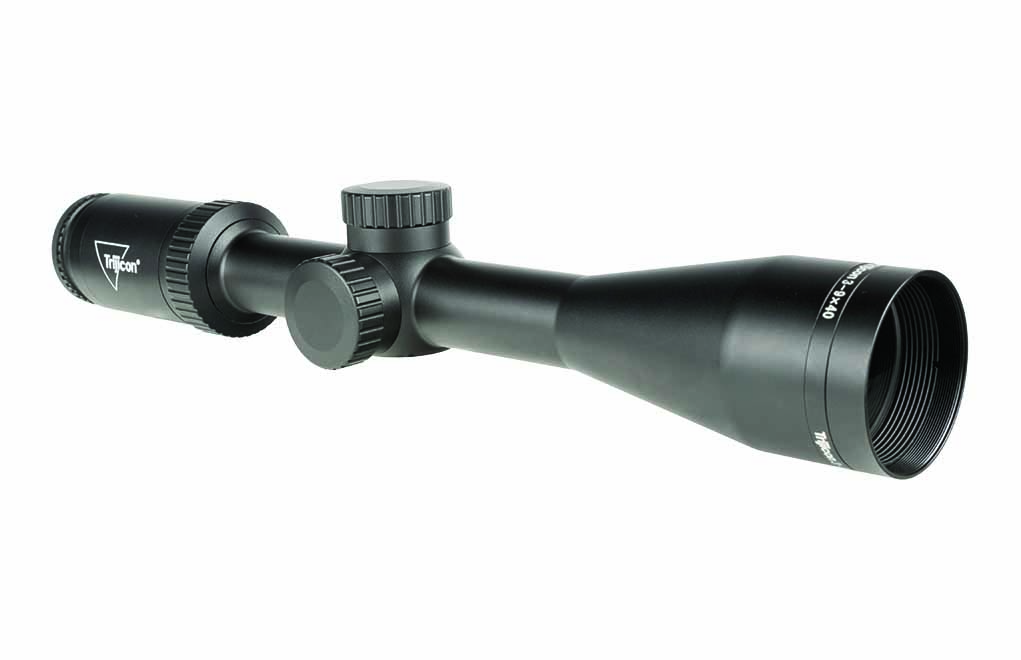
To be clear, the Huron scopes share the same military-grade construction and premium glass you’ll find in the company’s more expensive optics, so the Huron offers the same clarity, contrast and construction quality you’ll find on optics such as the AccuPoint. What the Huron doesn’t offer is Trijicon’s battery-free illumination tritium/fiber-optic lamps that are found in the AccuPoint line. The Huron offers AccuPoint-like clarity and light transmission in a package that costs about $500 less than the company’s flagship hunting optic. There are four Huron models available for 2020: 1-4x24mm, 3-9x40mm, 2.5-10x40mm, and 3-12x40mm. All are available with either 30mm or 1-inch tubes.
Trijicon is bucking the trend toward very large objective bells, but that’s not a bad thing. For starters, the notion that a very large 52mm or 56mm objective lens allows for better light transmission at dawn and dusk simply isn’t true. A 40mm lens with good-quality lenses and coatings will allow the shooter a clear view, even in low light.
The downside of those oversized objective bells is that they demand the rifle be mounted higher above the bore (and this, in turn, demands higher rings), and they weigh more than scopes with smaller objective lenses. Forty-millimeter objective lenses not only cut weight, they also allow the scope to be mounted closer to the rifle’s bore, and this prevents the shooter from having to increase comb height or break their cheek weld on the rifle to clearly see through the scope.
The compact 1-4x24mm scope measures just 10.4 inches long and weighs 15.9 ounces. At 17.8 ounces, the 3-12x40mm is very light for its magnification class, and that makes these optics ideal for sporter-weight rifles.
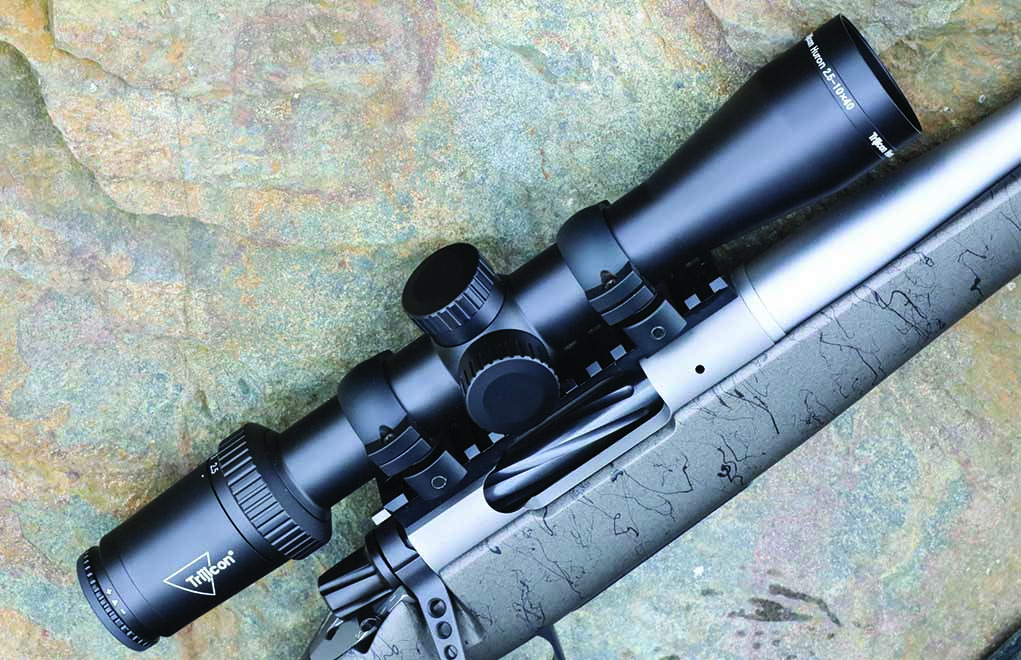
Huron scopes offer a long list of standard features that include MOA adjustments in both the 30mm and 1-inch models. They also come with Trijicon’s Easy-Focus Eyepiece so the diopter can be adjusted to match the shooter’s vision for a clear, consistent sight picture.
The scope body is made from 6061 aircraft-grade aluminum with a black satin finish that’s durable and glare-resistant, and the capped windage and elevation turrets can be adjusted without special tools. The fully multi-coated broadband anti-reflective glass lenses are equipped with an anti-scratch coating, and there are different second focal plane reticle options: Standard Duplex, German No. 4, and BDC Hunter Holds. The BDC Hunter Holds’ crosshair offers quick reference points for windage and elevation adjustments, and these scopes offer extremely wide fields of view (up to 33.8 feet at 100 yards for the 3-9×40; up to 95 feet at 100 yards for the 1-4×24).
Backed by Trijicon’s class-leading warranty, the Huron is a lot of glass for the money. MSRPs range from $650 to $699, and that’s a bargain for optics of this quality from a brand with such an outstanding track record.
Range-Testing the Huron
The Huron model I tested was the 2.5-10x40mm 30mm version with the BDC Hunter Holds reticle, and I tested it on an ER Shaw Mark X bolt-action rifle in 6mm Creedmoor. I knew part of the test would include a hunt in Canada’s far north for November whitetails, and the Mark X was the rifle I intended to take on that hunt—because, like the Huron, it promises excellent performance at an affordable cost.
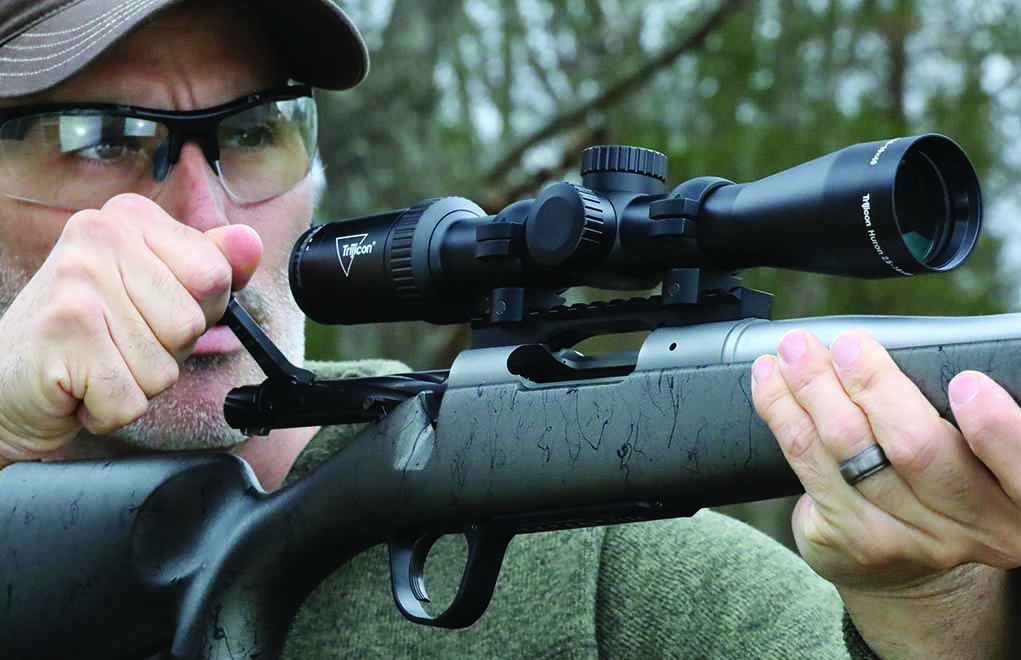
Because ER Shaw builds all its rifles to customer specifications, I designed the Mark X rifle myself, mating the Shaw action with a 24-inch, matte-finish sporter target barrel with an 11-degree crown, a 1:8 twist rate, and a Grade 5 walnut stock. Together, the rifle and optic carried an MSRP of less than $2,000, but the performance was equal to guns costing much more.
With the Huron mounted on the rifle, Hornady’s 103-grain ELD-X and 108-grain ELD Match bullets averaged groups between 0.6 and 0.87 inch at the range, and recoil from the 8-pound rifle was essentially nonexistent. The Huron’s reticle is wonderfully free of clutter, offering a wide and unobstructed sight picture.
The BDC Hunter Hold reticle is a great option for hunters, because it offers clear holdover points for fast reference in the field. While hunting, you might not have time to fool with making click adjustments to find the right elevation hold. The BDC reticle is faster—and that can make a huge difference when you’re presented with a narrow window of time to take a shoe.
Unlike other hunting scopes, the Huron’s click adjustments are precise and easy to count. What’s more, resetting the zero on your scope is fast and simple. To do so, you simply zero the scope, lift the dial, turn to the “zero” mark, and drop the dial. It locks into place, and you’re re-zeroed without the need to fiddle with tools. Not only is the design wonderfully simple, it’s also precise.
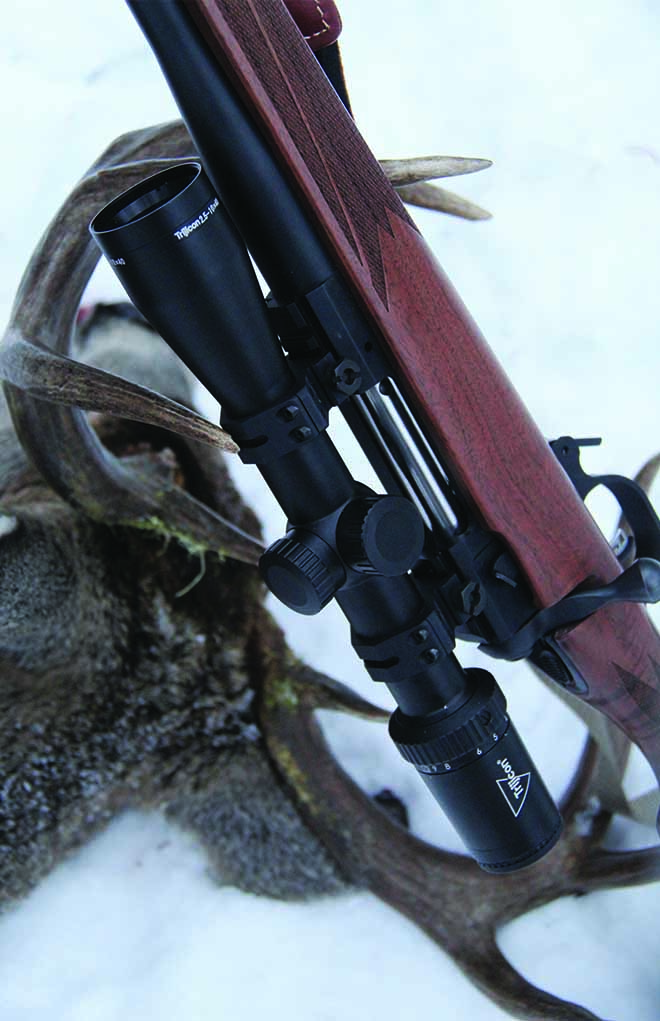
Into the Great North
Trijicon rates the Huron effective from -20 to +140 degrees Fahrenheit. Temperatures were at the low end of that range when I arrived in Saskatchewan in November for my whitetail hunt.
On the first morning in the Safari Rivers Outfitters camp, the thermometer read -12 degrees F, making for a bitterly cold ride to the blinds scattered deep within the Northern Provincial Forest. The formula for hunting Saskatchewan’s huge whitetail bucks is relatively simple: Position yourself along a prime travel corridor … and hope that the drive to reproduce compels the bucks to move during daylight hours.
I had complete confidence in my rifle/scope/load combination, and I knew that if a deer showed, the 6mm Creedmoor would do its job. If you believe the stories regarding body size on these big, Canadian bucks, you might be compelled to consider bringing a .30-caliber magnum on such a hunt. But the reality is that while northern-tier whitetails are larger than their southern cousins, they aren’t that much larger.
Nevertheless, like all whitetails, they’re elusive and hard to find, and that’s especially true in the massive forested tracts of northern Saskatchewan. It’s easy to lose heart and hope when the bitter cold seeps in and the woods are still and frozen, but the knowledge that the deer of a lifetime (several lifetimes, maybe) could be just out of sight around the closest stand of pines keeps you going.
The daylight hours are short in these woods, and even in full sun, the forested canopy blocks the light. It’s essential, therefore, to have a scope that offers excellent light transmission.
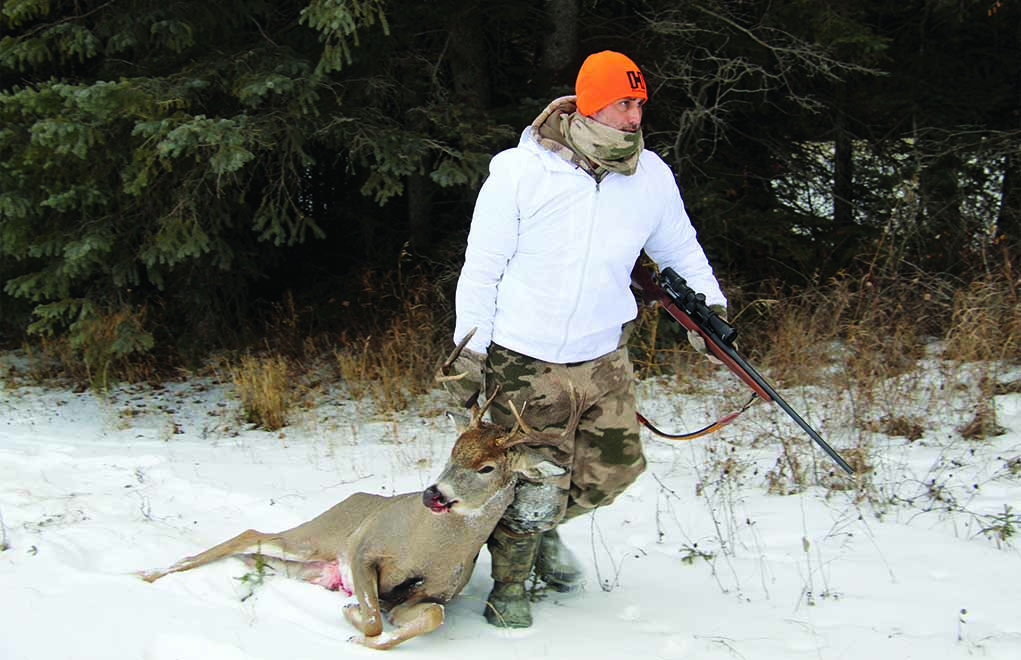
The concept that scopes “gather” light isn’t really true, but clear glass with good coatings goes a long way toward managing available light properly and providing hunters with a clear enough image to see their target.
As the days passed in the cold blind, I had several opportunities to test the Trijicon’s low-light efficiency, and it’s very good—on par with scopes costing much more. There’s very little color distortion, and the optic is clear, edge to edge. By the end of the second day, I’d thoroughly vetted the Huron as an observational tool in low light. Even so, I really needed to test it on game.
The first blind location was on a small ridge looking down into a winding creek that was frozen solid as steel pipe. The open understory was a mass of telephone-pole-straight pine trunks, and often, the only feature that betrayed the presence of an approaching deer was a horizontal, brown backline passing through the wall of vertical pines.
There was no shortage of deer in that pine forest, but the bucks that were hanging out around my quaint outpost in the big pine woods were immature. My guide, Joel, made the decision to move me to another area that was even deeper into the forest—far from anything resembling human habitation.
Scope Out More Optics Info:
- 8 Revolutionary Reticles For Long-Range Accuracy
- Buying the Perfect Precision Scope
- The Best Tactical Red-Dot Performance-to-Price Option?
- Shifting Winds: SIG BDX Changing Shooting For The Better
When the sun “warmed” (a relative term, I assure you), and chickadees began peeking into the blind windows, I could see a pair of does 100 yards ahead of me. I hoped that they would bring in a buck, but after moiling around for over an hour, they vanished into the trees, and the woods fell silent.
At noon, I pulled my lunch bag from underneath my outer layer of clothing (to keep everything from freezing) and peeled the wrapper off my sandwich with the Shaw rifle across my legs. I’d just finished when I saw movement through the trees.
It was a buck, and although he wasn’t one of the giants that are sometimes found in these woods, he was mature and far better than anything I’d seen. I slipped the rifle into position on the shooting sticks and turned the dial on the 2.5-10x40mm Huron to max power.
The buck turned to the right, quartering slightly away from me. I slid the safety forward and held the crosshairs of the Trijicon at the seam between the buck’s leg and chest a third of the way up his body. When the rifle was steady, I exhaled sharply, settled myself and pressed the trigger.
The afternoon silence was shattered by the sharp crack! of the 6mm Creedmoor, and the buck fell, nose-first, into the snow. He then managed to regain his feet before vanishing out of sight. I listened for any sound: Other than a series of four or five thumps in the snow, there was nothing.
The Hornady bullet had passed through the deer’s lungs and broke the off-side leg, and the deer had barely made it out of sight before expiring. He was a better buck than I thought—fat, healthy, and with very dark main beams that reached around and nearly touched. By the time I reached him and snapped a few pictures, the day’s light was quickly fading, and I radioed that I had a deer on the ground and for someone to come and pick me up.
I came away from that hunt very impressed with the Huron’s performance, and it’s advantage to hunters that Trijicon is offering its high-quality scopes at a price that’s more manageable for the average whitetail hunter. The Huron is marketed as the “ultimate whitetail hunter’s scope,” and it performed exceptionally well in some very challenging conditions.
Trijicon Huron 2.5-10x40mm Specs
Tube diameter: 30mm
Tube material: 6061 aluminum
Eye relief: 2.4-3.3 in.
LengtH: 12.5 in.
Weight: 18.2 oz.
Finish: Satin black
Reticle: Trijicon BDC Hunter Holds
Adjustments: ¼ MOA
Adjustment range: 70 MOA total
Exit pupil: 0.58-0.16 in.
Focal plane: Second
MSRP: $699
For more information on the Trijicon Huron scope, please visit trijicon.com.
Editor's Note: This article originally appeared in the September 2020 issue of Gun Digest the Magazine.

Next Step: Get your FREE Printable Target Pack
Enhance your shooting precision with our 62 MOA Targets, perfect for rifles and handguns. Crafted in collaboration with Storm Tactical for accuracy and versatility.
Subscribe to the Gun Digest email newsletter and get your downloadable target pack sent straight to your inbox. Stay updated with the latest firearms info in the industry.

![Best Concealed Carry Guns In 2025 [Field Tested] Wilson Combat EDC X9S 1](https://gundigest.com/wp-content/uploads/Wilson-Combat-EDC-X9S-1-324x160.jpg)


![Best 9mm Carbine: Affordable PCCs [Tested] Ruger Carbine Shooting](https://gundigest.com/wp-content/uploads/Ruger-Carbine-Shooting-100x70.jpg)
![Best AR-15: Top Options Available Today [Field Tested] Harrington and Richardson PSA XM177E2 feature](https://gundigest.com/wp-content/uploads/Harrington-and-Richardson-PSA-XM177E2-feature-100x70.jpg)

I totally agree on the objective lens for hunting rifles. My choice last year for my 6.5 PRC Browning X-Bolt Pro is:
BUSHNELL ELITE LRTS 4.5 – 18 x 44 scope with an illuminated G3 small “Xmas tree” reticle good for wind holds here in Nevada. That scope and the long range 6.5 PRC cartridge are a good combo for all big game in Nevada.
I always carry 10X rangefinder binoculars for more accurate shot placement beyond 200 yards. It gives me the hold readout for my cartridge/bullet weight and compensates for high angles. I’ve “justified” the binocular’s hold recommendations at my gun club’s steel range which goes out to 1.100 yards.